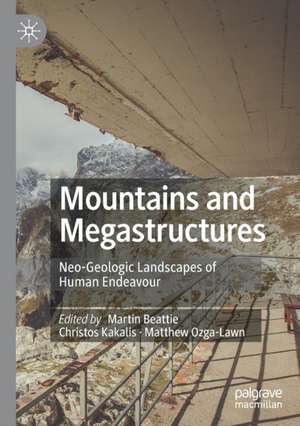Mountains and Megastructures: Neo-Geologic Landscapes of Human Endeavour
Editat de Martin Beattie, Christos Kakalis, Matthew Ozga-Lawnen Limba Engleză Paperback – 23 dec 2021
| Toate formatele și edițiile | Preț | Express |
|---|---|---|
| Paperback (1) | 389.88 lei 43-57 zile | |
| Springer Nature Singapore – 23 dec 2021 | 389.88 lei 43-57 zile | |
| Hardback (1) | 394.51 lei 43-57 zile | |
| Springer Nature Singapore – 22 dec 2020 | 394.51 lei 43-57 zile |
Preț: 389.88 lei
Nou
Puncte Express: 585
Preț estimativ în valută:
74.61€ • 77.61$ • 61.60£
74.61€ • 77.61$ • 61.60£
Carte tipărită la comandă
Livrare economică 14-28 aprilie
Preluare comenzi: 021 569.72.76
Specificații
ISBN-13: 9789811571121
ISBN-10: 9811571120
Pagini: 328
Ilustrații: XIX, 328 p. 60 illus., 38 illus. in color.
Dimensiuni: 148 x 210 mm
Greutate: 0.46 kg
Ediția:1st ed. 2021
Editura: Springer Nature Singapore
Colecția Palgrave Macmillan
Locul publicării:Singapore, Singapore
ISBN-10: 9811571120
Pagini: 328
Ilustrații: XIX, 328 p. 60 illus., 38 illus. in color.
Dimensiuni: 148 x 210 mm
Greutate: 0.46 kg
Ediția:1st ed. 2021
Editura: Springer Nature Singapore
Colecția Palgrave Macmillan
Locul publicării:Singapore, Singapore
Cuprins
Introduction.- Part 1 Framing Mountains/Megastructures.- Chapter One: Border versus Boundary: The Holy Mountain and the Inhabitation of its Periphery.- Chapter Two: From Picturesque Detachment to Bodily Engagement; the Entwined Histories of Photography, Architecture and Mountaineering.- Chapter Three: House-building in the Alps with Ruskin Tyndall or CZOgraphy: an eco-criticism for the Critical Zone.- Chapter Four: Bachelard’s Phenomenology and Verticality.- Chapter Five: Chthonic Countermeasures: a geological conte.- Part 2 Mountains.- Chapter Six: Everest Death Zone.- Chapter Seven: The Making and Unmaking of Kunanyi.- Chapter Eight: Lost on the edges of empire: John Stapylton Grey Pemberton’s expedition to Darjeeling and the “snowy ranges”.- Chapter Nine: Conquering Dragons.- Part 3 Megastructures.- Chapter Ten: Artificial Mountains.- Chapter Eleven: Terremoto in Palazzo.- Chapter Twelve: How Old Is the Barcelona Pavilion?.- Chapter Thirteen: ‘Crowding the Stoop’. Climbing the Mega-Structures of Science Fiction.- Chapter Fifteen: Verticalities of the Imagination. Futurity and the Contemporary in Urban Science Fiction.- Chapter Sixteen: A Megastructure and a Mountain. Two Ways of Thinking about Architecture Culture.- Chapter Seventeen: Mount Fuji VS The Megastructures of Tokyo.
Notă biografică
Dr. Martin Beattie is a Senior Lecturer in Architecture at the School of Architecture, Planning and Landscape, Newcastle University, UK.
Dr. Christos Kakalis is a Lecturer in Architecture at the School of Architecture, Planning and Landscape, Newcastle University, UK.
Dr. Matthew Ozga-Lawn is a Lecturer in Architecture at the School of Architecture, Planning and Landscape, Newcastle University, UK.
Textul de pe ultima copertă
This book explores the shared qualities of mountains as naturally-formed landscapes, and of megastructures as manmade landscapes, seeking to unravel how each can be understood as an open system of complex network relationships (human, natural and artificial). By looking at mountains and megastructures in an interchangeable way, the book negotiates the fixed boundaries of natural and artificial worlds, to suggest a more complex relationship between landscape and architecture. It suggests an ecological understanding of the interconnectedness of architecture and landscape, and an entangled network of relations. Urban, colonialist, fictional, rural and historical landscapes are interwoven into this fabric that also involves discontinuities, tensions and conflicts as parts of a system that is never linear, but rather fluid and organic as driven byhuman endeavor.
Caracteristici
Undertakes an examination of mountains and megastructures as interrelated phenomena, drawing on the multidisciplinary nature of architectural research Examines mountains and megastructures in an interchangeable way, uniquely negotiating the fixed boundaries of natural and artificial worlds to suggest a more complicated relationship between landscape and architecture Includes historical, speculative, literary, performative, geographic, visual, social and participatory investigations to contribute to the wider academic discourse on cultural and political landscapes, demonstrating the potential of architectural research in its broadest sense
